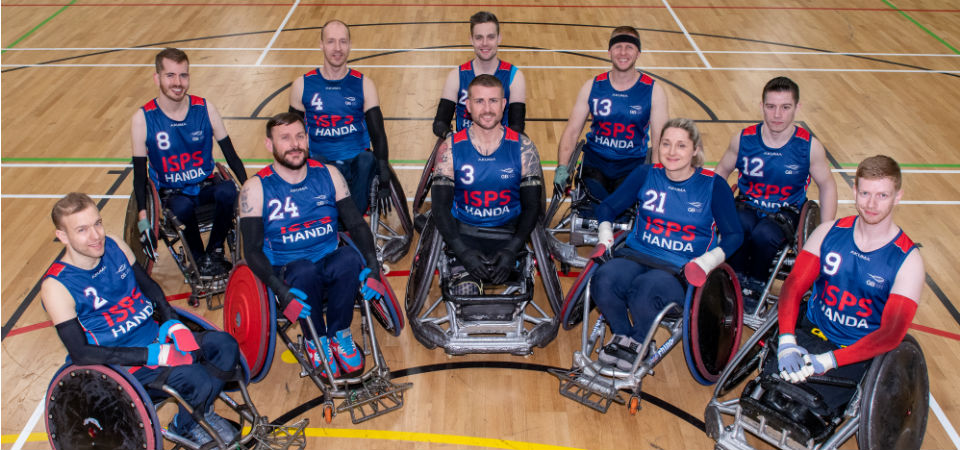8 May 2019
Sharpening a winning edge: GB wheelchair rugby team aims to increase its tournament winning chances
Britain’s wheelchair rugby squad will visit Loughborough University’s world-renowned sports science labs this month in preparation for the summer’s IWRF European Championships.
The GB Team are favourites to win the tournament, being held in Denmark during August, but the team is far from complacent and the tournament has an added importance because it is also a qualifier for the 2020 Paralympic Games.
In May, the men and women of the Great Britain line-up will head to Loughborough to be tested for their fitness, anaerobic capacity, speed and power.
Testing will take place over a month at the School of Sport, Exercise and Health Sciences (SSEHS), recently ranked number one in the world for sports-related subjects for the third year running.
Sports scientist Tom O’Brien said: “Players will come into the lab where they will complete a submaximal aerobic test followed by a VO2max test, which helps me as a sport scientist identify their current maximal fitness capacity.
“Alongside this, I’ll be doing some sprint profiling on our wheelchair ergometer to calculate the players maximal anaerobic capacity.
“Ultimately, this will allow me to see how fast and how powerful they are and help identify the components of fitness each player might need to work on to give them the best possible advantage over their opponents.”
David Pond, Chief Executive of GB Wheelchair Rugby, said the organisation was pleased to continue its work with the team from the Peter Harrison Centre for Disability Sport, whose support and expertise brings real performance benefit.
He said: “The support we get from the Peter Harrison Centre is a critical part of ensuring we are at our peak performance for these big events.
“We started the year strongly with a silver medal at the King Power Quad Nations in Leicester and we now want to maintain that momentum by building on our record of 6 European Championship wins.”
The visit will also lay the groundwork for Tokyo 2020, and to win the European Championships would mean automatic qualification for GB.
The summer Paralympic games will see athletes compete in extreme conditions with temperatures likely to exceed 30˚C and humidity reaching around 70 per cent.
The environment will be challenging for wheelchair sportsmen and women, especially those with spinal cord injuries.
“Many athletes with spinal cord injuries have impaired thermoregulatory capacity,” said Tom. “Which means the players’ ability to sweat and cool themselves naturally is heavily affected.
“The consequences may lead to reduced central nervous system drive to the skeletal muscles and ultimately fatigue with a detrimental effect on performance.
“Although there is some research looking into cooling techniques, little research has been conducted on the effects of prior cooling following exposure to heat, which is likely to occur in Tokyo.”
The researchers at Loughborough will, therefore, be looking into the Tokyo climate and its effects on core temperature and performance to explore and present a cooling strategy to help the players perform at their best.
Tom said: “There are a number of internal cooling methods that have been shown to increase core temperature capacity and increase submaximal running time in the heat in able-bodied populations.”
David Pond added: “We are incredibly grateful for the support of the Peter Harrison Centre for Disability Sport – optimising their research will help give us a competitive edge, which is as critical in our sport as it is in any able-bodied and disabled elite sport where games are won and lost on narrow margins.”
About wheelchair rugby
In 1977, in Winnipeg, Canada, a group of quadriplegic athletes were looking for an alternative to wheelchair basketball and invented Murderball – now known as wheelchair rugby.
The new game kept some elements of its predecessor, such as the hardwood court, and its dimensions — 28 metres long by 15 metres wide.
But they also added rules from ice hockey, handball and rugby union.
The game is played by two teams of four players, made up of male and female athletes, chosen from a squad of up to 12.
It is split into four eight-minute quarters, with overtime periods if the game is tied.
Just as in rugby, wheelchair rugby relies on physical contact.
However, players are not allowed clash, it’s only the wheelchairs that are permitted to connect.
Direct physical contact between players is not permitted.
The sport is governed by the International Wheelchair Rugby Federation (IWRF) which was established in 1993.















